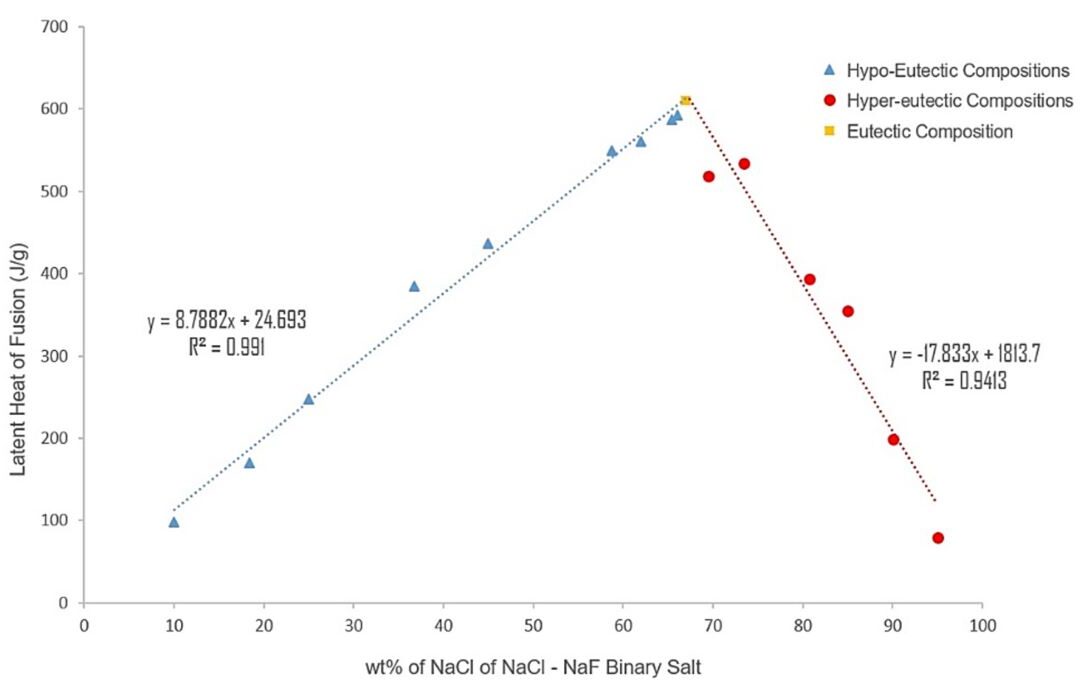The AMDTR group has been involved in ASTRI’s advanced materials program for almost a decade, which has enabled the group to expand in the molten salt research space, specifically for Concentrated Solar Power (CSP) energy applications. The group’s capabilities include the production of molten salt mixtures, thermo-physical characterisation of salts, optimisation and prediction of salt properties, and compatibility testing with alloys.
Optimisation and prediction of salt properties
Our researchers have expertise in the modelling and estimation of the various thermo-physical properties of salt mixtures suitable as a medium for CSP energy storage. These properties include melting temperature, latent heat of fusion, heat capacity, density, thermal conductivity and phase diagrams. This is done by using various predictive numerical formulations and the assistance of programming software such as Factsage(TM) and Thermocalc(TM). For phase change materials, we have also developed an empirical method for optimising the eutectic composition of a salt mixture to maximise its latent heat of fusion.

Phase diagram for sodium chloride – sodium fluoride salt mixture obtained using program Factsage, eutectic point determined to be 72 NaCl – 18 NaF wt%

Using our novel empirical method for determining the eutectic point for sodium chloride – sodium fluoride mixture, we determined a maximum latent heat is measured when mixture is at 67 NaCl – 33 NaF wt% (corresponds with true eutectic)
For more information on the available techniques and our approach, please read the following references:
R. Raud, S. Bell, K. Adams, R. Lima, G. Will, and T. A. Steinberg, “Experimental verification of theoretically estimated composition and enthalpy of fusion of eutectic salt mixtures,” Sol. Energy Mater. Sol. Cells, vol. 174, pp. 515–522, Jan. 2018, doi: 10.1016/j.solmat.2017.09.033.
R. Raud, S. Bell, T.C. Ong, G. Will, and T. A. Steinberg, “Optimized Salt Selection for Solar Thermal Latent Heat Energy Storage,” Adv. Sustain. Syst., vol. 2, no. 11, p. 1800074, Nov. 2018, doi: 10.1002/adsu.201800074.
T.C. Ong, E. Graham, G. Will, and T. A. Steinberg, “An innovative empirical method for the accurate identification of the eutectic point of binary salts for solar thermal energy storage,” Mater. Today Commun., vol. 26, p. 101864, Mar. 2021, doi: 10.1016/j.mtcomm.2020.101864.
Salt production and measurement of thermo-physical properties
With access to a variety of local and international suppliers of salt products, including such brands as Thermofisher and Sigma Aldrich, the AMDTR group is able to produce any mixture of salt. Depending on the testing requirements, we are able to produce high purity grade or technical grade salt in small or bulk amounts. We are also able to characterise the properties of the salt mixture and verify theoretical data using a suite of analysis equipment available to the group via QUT’s Central Analytical Research Facility (CARF). CARF has a physical properties laboratory with equipment to characterise properties such as melting point, heat capacity, latent heat, thermal conductivity/diffusivity, thermal expansion, viscosity and thermal stability.
Find out more about the analysis equipment available from CARF.

Equipment available from CARF include the Netzsch STA 449F3 Jupiter simultaneous thermal analyser, which is capable of determining thermal stability, heat capacity, latent heat, endothermic/exothermic processes and events